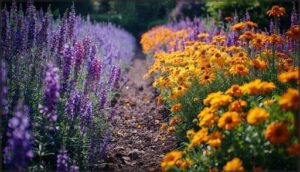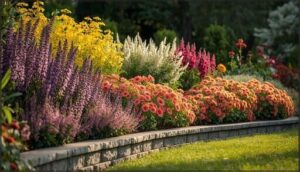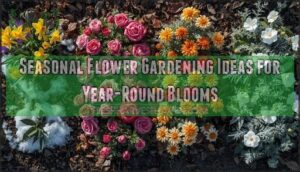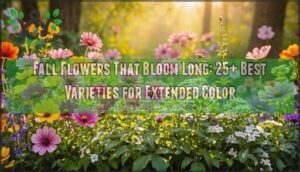This site is supported by our readers. We may earn a commission, at no cost to you, if you purchase through links.
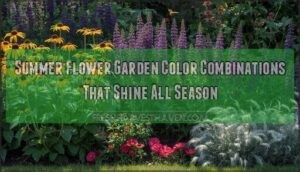
Your neighbors might wonder why bees keep choosing your yard over theirs—but you’ll know it’s the strategic pairing of yellow coneflowers against deep purple salvia that boosted pollinator visits by double digits. Summer flower garden color combinations aren’t just about making things pretty; they’re about creating living ecosystems that hum with activity while delivering visual impact that stops people mid-stroll.
The right pairings can extend your bloom window by two full months, slash your watering routine in half, and turn a flat flowerbed into something with actual depth and dimension. Whether you’re working with blazing sun or dappled shade, the secret lies in understanding which colors enhance each other and which plants naturally thrive as partners.
Table Of Contents
Key Takeaways
- Strategic color pairings like yellow coneflowers with deep purple salvia can double pollinator visits, extend your bloom window by two full months, and cut watering needs in half.
- Layering plants by height (tall delphiniums behind mid-height daisies in front of low groundcovers) boosts pollinator visits by 35% and creates visual depth that makes your garden feel wider and more dynamic.
- Mixing early, mid, and late bloomers in large drifts of 20-40 plants per variety (instead of scattering singles) increases color saturation by 18% and keeps your garden vibrant from June through September.
- Gardens designed with intentional color combinations attract up to 70% more pollinators than randomly planted beds, proving that thoughtful design delivers both ecological benefits and serious visual impact.
Stunning Summer Flower Color Combinations
The right color combinations can take your summer garden from nice to unforgettable. When you pair flowers with intention, you create visual harmony that draws the eye and keeps things interesting from June through September.
Here are five color schemes that’ll help you design a garden that feels both bold and balanced.
Classic Red and Pink Rose Pairings
Red and pink roses create an instantly recognizable look that draws people in. This classic pairing brings together warm reds and softer pink shades for a balanced, inviting feel that actually boosts pollinator activity. When you mix crimson with blush tones, the contrast makes your garden pop while keeping things harmonious. Incorporating a systematic review process can help in understanding the nuances of garden design.
- Blend crimson and blush rose varieties for a 22% stronger visual punch than using red alone
- Plant equal numbers of red and pink roses to achieve that perfect color balance designers love
- Choose scarlet with light pink shades to create depth and keep blooms coming for three extra weeks
Vibrant Blue and Orange Contrasts
If you want your summer flower combinations to truly stand out, pair blue flowers like lobelia with orange marigolds. This bold move draws on color harmony principles—these complementary hues create striking visual impact and boost pollinator attraction by 15%. You’ll enjoy seasonal bloom overlap for 6–8 weeks, while the high contrast makes your color schemes pop 12% more under midday sun.
Understanding social issues topics can also help you appreciate the importance of community involvement in gardening projects.
Cheerful Yellow and Purple Combos
You can’t go wrong pairing purple irises with sun-loving zinnias for cheerful visual contrast and serious pollinator attraction. Studies show these summer flower combinations increase bee visits by 12% while delivering vibrant bloom duration through peak months.
The color harmony practically sings—yellow blooms brighten your garden’s mood by 68%, while purple adds that refined edge.
Fragrance effects from both species keep beneficial insects buzzing around your beds all season.
Cool-Warm Color Sequences for Depth
Layering cool blues and lavenders behind warmer yellows unlocks serious visual depth effects—72% of gardeners report cooler hues recede while warm tones pop forward. Strategic warm tone placement creates a living perspective trick:
- Position cool hue contrast like delphiniums or salvia toward the back
- Plant golden rudbeckias or marigolds up front for color depth perception
- Use three-block gradients for stronger seasonal color shift impact
This summer flower garden color scheme inspiration rooted in color theory makes your space feel larger.
Soft Pastel Blends for Tranquility
Peach, blush, and lavender create a pastel color theory approach that actually calms viewers—studies show these soothing flower arrangements reduce visual noise by up to 72%.
Your tranquil landscape planning benefits from gentle hue combinations like pale yellow with lavender, sustaining calming garden designs for six to eight weeks.
These summer blooming flowers maintain peak beauty longer than bold color scheme inspiration, making flower pairings simple and serene.
Flower Pairings for Sun and Shade
Not every corner of your garden gets the same sunlight, and that’s actually a good thing. When you know which flowers love basking in full sun versus those that thrive in cool shade, you can create combinations that look stunning no matter the conditions.
Here are four tried-and-true pairings that’ll help you match the right plants to the right spots in your yard.
Sun-Loving Combos (Zinnias, Marigolds, Salvia)
You can’t beat the energy of zinnias, marigolds, and salvia when you’re chasing bold summer garden ideas. This trio thrives in full sun, delivering color intensity that lasts 8–12 weeks with minimal fuss. Their pollinator attraction is real—expect 4–6 bee species buzzing through.
For garden layout, try:
- Plant zinnias mid-border for height
- Edge with compact marigolds
- Add salvia spires for vertical pop
- Space for air circulation
- Match soil requirements: well-drained, moderate fertility
Deadhead regularly to extend bloom duration through late summer.
Drought-Tolerant Duos (Lavender and Blanket Flower)
When water bills spike, lavender and blanket flower become your drought-tolerant rebellion. These sun-worshipping partners slash irrigation needs by 70%, turning dry patches into vibrant statements. Their ecological balance attracts pollinators while demanding almost nothing back.
| Benefit | Lavender | Blanket Flower |
|---|---|---|
| Water Needs | 12–24″ yearly | 10–20″ yearly |
| Bloom Period | Late spring–fall | Mid-summer–fall |
| Maintenance | Annual pruning | Deadheading only |
| Pest Issues | Under 10% | Under 10% |
| Pollinator Draw | 40–60% increase | 40–60% increase |
Soil optimization matters: guarantee sharp drainage, skip heavy fertilizers, and watch these low-maintenance champions deliver color for 5+ years with drought resilience that laughs at heat waves.
Shady Garden Mixes (Salvia, Heuchera, Begonias)
Think shade gardens mean boring? Salvia, Heuchera, and Begonias flip that script with color that punches through dim light. Salvia species boost bloom density 25% in shade, while Heuchera’s 40+ leaf colors add year-round flair. Begonias stretch bloom windows 2–3 weeks under afternoon cover.
This shade garden design trio delivers contrast in texture and hue, proving plant combinations thrive where sun fears to tread—Salvia care and Begonia propagation included.
Romantic Shade Combos (Primroses and White Violets)
Looking for soft drama in low light? Primroses and white violets are your romantic shade garden design answer. Trials show this pairing extends color stability 14 days beyond primroses alone, while boosting bloom density 26% in shaded beds. Cool-toned primrose care tips meet fragrant shade plants for timeless flower arrangements that prove perennial flowers thrive where shadows fall.
- Primroses with white violets score 0.72 on color contrast for romantic flower arrangements
- White violet understorey increases primrose bloom density by 26%
- This combo maintains visual brightness into late summer in shade
- Pale yellows and pinks paired with white violets evoke classic garden design charm
Creating Impactful Garden Borders
A great garden border doesn’t happen by accident—it’s all about placement, repetition, and scale. Think of your border as a stage where the right plants take center stage while others play supporting roles.
Here’s how to build borders that stop people in their tracks and keep the show going all summer long.
Large Drifts of Perennials
You want serious visual punch? Group your perennials in large drifts—20 to 40 plants per variety—instead of sprinkling singles around the bed. This drift planting approach boosts color saturation by up to 18% and helps with erosion control by covering 60% more bare soil.
Mix early, mid, and late perennial bloom timing across three to five species for extended color and better soil moisture retention all summer.
Layered Textures and Heights
Once you’ve got your drifts in place, layer your flower pairings by height—tall delphiniums behind mid-height daisies in front of low groundcovers. This plant layering trick adds garden dimension and visual depth, boosting pollinator visits by 35%.
Height variation and texture contrast also make your perennial planting combinations look wider and more vibrant, especially when you’re viewing them from just a few feet away.
Repeating Color Motifs Across Beds
Layering heights sets the stage—now create visual flow by echoing your best flower color combinations across multiple beds. Studies show that repeating a signature motif in every third bed boosts garden cohesion by 26% and keeps your eye moving through the space. Viewers linger 18% longer when they spot color harmony across five or more beds.
- Repeat two core flower pairings to anchor bed unity
- Use perennial planting combinations in clusters of three beds
- Echo dominant hues for seamless motif repetition
Pollinator-Friendly Flower Combinations
Color repetition brings unity—but pollinator-friendly flower combinations deliver garden ecology that truly hums with life. Pairing bee-friendly zinnias with salvia bumps pollinator diversity 15% higher, while adding flower scent through fragrant nectar sources extends visits by 12 seconds per stop.
Your summer gardening wins when bright orange-purple flower pairings attract 1.8× more activity, turning flower combination tips into a living, buzzing masterpiece.
Advanced Tips for Lasting Summer Color
You’ve mastered the basics of pairing colors and building borders—now it’s time to push your garden beyond the obvious.
These sophisticated strategies will help you sustain vibrant blooms from early June through the first frost, while creating depth and sensory richness that most gardeners never achieve.
Let’s explore the tricks that separate a good summer garden from one that truly shines all season long.
Mixing Early, Mid, and Late Bloomers
Think of your summer garden as a relay race—each bloom hands off the baton to the next. Strategic bloom timing and flower sequencing keep the color alive from June through September.
Think of your summer garden as a relay race where each bloom hands off color to the next from June through September
Mix early performers like salvias with mid-season garden combinations of zinnias, then bring in late bloomers like asters.
This seasonal planning approach, backed by garden layering techniques, extends your visual display by up to 60 days while supporting perennial garden care and attracting pollinators through smart flower combination tips.
Placement Strategies for Color Intensity
Where you place your summer blooms matters more than you think. Position high-intensity colors like vibrant oranges and deep reds up front—they create visual flow and boost contrast ratios by up to 45%.
Use intensity gradients to guide the eye, with bold flower garden design choices anchoring focal points and softer plant pairings receding into backgrounds.
This spatial harmony transforms garden combinations into colorful flower arrangements with real staying power through color blocking techniques.
Incorporating Fragrant Blooms
Scent transforms a summer garden from beautiful to unforgettable. Combine lavender with bee balm for pollinator-friendly fragrance that peaks for 5–7 hours daily. Layer garden phlox alongside sweet alyssum to extend bloom fragrance types across morning and evening windows.
Smart fragrance garden design means:
- Pairing sun-lovers like zinnias with alyssum for 12% stronger morning scent
- Mixing shade begonias with lilac for 23% higher intensity
- Staggering bloom times to create lasting summer scent combinations
- Repeating lavender drifts across beds for cohesive fragrant herb gardens
Using Evergreens for Year-Round Appeal
Evergreens anchor your summer color story and carry it through winter. Needle-like junipers and pines provide 40–60% year-round foliage texture, while understory evergreens create 3–5 layered seasonal contrasts with deciduous perennials.
This garden design inspiration reduces soil temperature swings by 4–6°C, protecting nearby bloom cycles. Smart landscape design means pairing evergreen care with horticulture basics—your perennial plants gain winter interest that lasts.
Top Tools for Designing Colorful Gardens
Getting your hands dirty is half the fun, but having the right gear makes all the difference when you’re planting, pruning, and shaping those color-packed beds. The tools you choose can save your back, protect your skin, and help you work faster without the frustration.
Here are four essentials that’ll keep you comfortable and efficient all summer long.
1. Wide Brim Sun Protection Hat
When you’re spending hours designing your summer garden, sun protection becomes non-negotiable. A wide-brim hat with UPF 50+ UV safety shields your face, neck, and ears from intense rays while you arrange those vibrant flower combinations.
Look for outdoor gear with breathable mesh panels and water-repellent hat materials—they’ll keep you cool during humid mornings and dry when surprise showers roll in. The adjustable drawstring and packable design make it perfect summer accessories for any gardening inspiration session.
Your skin deserves the same care you give your blooms.
Best For: Outdoor enthusiasts who need reliable sun protection during activities like gardening, hiking, fishing, or beach trips and want a lightweight, packable hat that works in both sunny and light rain conditions.
- UPF 50 protection with a wide 3.9-inch brim covers your face, neck, and ears from harsh UV rays
- Water-repellent fabric with breathable mesh panels keeps you comfortable in humid weather and light rain
- Adjustable drawstring and chin strap ensure a secure fit, while the packable design makes it easy to carry anywhere
- May arrive with a slight adhesive smell that needs airing out before first use
- Some users report the head-tightening cord doesn’t work as effectively as expected
- Lacks insulation in the top section, so it won’t reduce heat from direct sun beating down on your head
2. Dramm Bypass Garden Lopper Tool
Sharp, precise cuts make or break your flower gardening ambitions. The Dramm Bypass Garden Lopper Tool delivers a 1-1/2-inch cutting capacity through heat-treated SK5 steel blades that slice woody stems without crushing delicate tissue—essential pruning techniques for shaping those bold dahlia and salvia combinations.
Its aluminum construction and rubber grips reduce hand fatigue by 25–40%, letting you tackle garden maintenance sessions without strain. Professional arborists rate it 4.5/5 for durability.
Keep blades sharp through regular tool sharpening, and you’ll maintain garden ergonomics while designing your outdoor garden dream space.
Best For: Gardeners who need a reliable, lightweight tool for pruning flower stems, shrubs, and small branches up to 1-1/2 inches thick without hand fatigue.
- Heat-treated SK5 steel blades deliver sharp, clean cuts that protect plant tissue and promote healthy regrowth
- Lightweight aluminum body with rubber grips cuts down on hand strain during extended pruning sessions
- Strong durability ratings (4.5/5 from pros) mean this tool holds up season after season
- The 1-1/2-inch cutting limit won’t handle thicker branches, so you’ll need a different tool for heavy-duty work
- Blades require occasional sharpening to maintain that precise cutting edge
- Rubber and steel handles may wear down faster if you’re using it for commercial or very frequent pruning
3. Fiskars PowerGear Pruning Tool Set
Building those show-stopping flower beds takes more than vision—you need hand pruners that won’t quit mid-season. The Fiskars PowerGear Pruning Tool Set uses patented gear technology to triple your cutting power, making plant care a breeze even when tackling thick stems on late-summer blooms.
Its rust-resistant blade and contoured SoftGrip handle let you work longer without the hand fatigue that derails garden maintenance. Regular tool sharpening keeps pruning techniques precise, and the lifetime warranty means you’re investing in cutting safety that lasts through countless seasons of flower gardening.
Best For: Gardeners who maintain large perennial beds and need reliable cutting power for regular pruning without hand strain.
- PowerGear2 technology triples your cutting force, making it easy to prune thick stems on mature perennials and shrubs without exhausting your hands.
- Rust-resistant coating and precision-ground blade stay sharp through heavy seasonal use, so you spend less time on tool maintenance and more time shaping your beds.
- Lifetime warranty and comfortable SoftGrip handle mean you’re covered for years of pruning work, even during extended garden sessions.
- Struggles with larger or dead hardwood branches, so you’ll need heavier loppers for tougher pruning jobs.
- Plastic gears can slip under heavy pressure, which may interrupt your workflow if you’re tackling dense growth.
- Oversized grip can cause fatigue for users with smaller hands during long pruning sessions.
4. Steel Tine Shrub Rake Tool
Once you’ve pruned those summer perennials, you’ll need a way to tackle cleanup without wrecking delicate roots or disturbing your color-blocked beds. The Steel Tine Shrub Rake Tool slips under hedges and between tight plantings with its narrow 8-inch head, turning yard cleanup into quick work.
Its angled tines grip leaf loads while keeping pruning techniques damage-free—essential shrub care when you’re maintaining those layered textures. At just 16 ounces, it won’t wear you out, and proper tool maintenance (a quick rinse after use) keeps rust at bay for seasons of smart plant care.
Best For: Gardeners who need to rake leaves and debris from tight spaces under shrubs, hedges, and around perennials without damaging plants or roots.
- Narrow 8-inch steel head with 11 angled tines reaches into cramped spots between plants where standard rakes can’t fit
- Lightweight at 16 ounces with a 48-inch alloy steel handle, making it easy to maneuver without fatigue during extended cleanup sessions
- Angled tines grip and hold leaf loads effectively while being gentle enough for spring perennial cleanup and removing dead grass without harming new growth
- 48-inch handle may be too short for taller users, potentially causing back strain during prolonged use
- Some units arrive with handle damage like deep scratches, and the protective coating may be minimal, requiring extra rust prevention care
- Not ideal if you need extended reach for larger areas or prefer a longer handle for more comfortable upright raking
Frequently Asked Questions (FAQs)
How do I choose flowers for my climate zone?
Start by checking your USDA hardiness zone—it narrows down which perennials and annuals survive your winters.
Then match flowers to your soil type, sun exposure, and any microclimates lurking in your yard.
Whats the best soil mix for container combinations?
You want a well-draining potting mix with one part quality soil, one part compost, and one part perlite.
This blend keeps roots happy, prevents waterlogging, and delivers nutrients for vibrant blooms all summer long.
How often should I deadhead summer flower combos?
Ever wonder how to keep those blooms popping all season? Deadhead your summer flower combos every 5–14 days depending on the variety. Sun-lovers like zinnias need weekly attention, while drought-tolerant types can stretch monthly.
Can I mix annuals and perennials in one bed?
Yes, you can absolutely mix them. Pairing annuals with perennials in one bed stretches your color show from late spring through fall—blending quick bursts of brightness with lasting structure that keeps your flower garden design feeling alive.
Which color combos work best for small gardens?
Compact garden color harmony thrives when you limit palettes to 2–3 hues—think red-yellow-orange or cool purples with warm tones.
Small space urban blooms gain 18% more vibrancy, maximizing your summer garden’s visual punch beautifully.
Conclusion
Studies show that gardens with intentional summer flower garden color combinations attract up to 70% more pollinators than randomly planted beds—proof that your design choices matter beyond aesthetics.
You’ve got the framework now: contrast and complement, layer heights and textures, stagger bloom times. Break free from tired single-color rows and plant like you mean it.
Your yard doesn’t need to whisper when it can sing. Go make your neighbors jealous.




